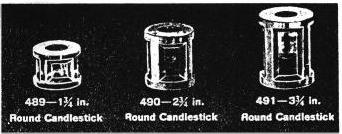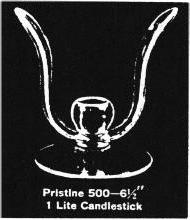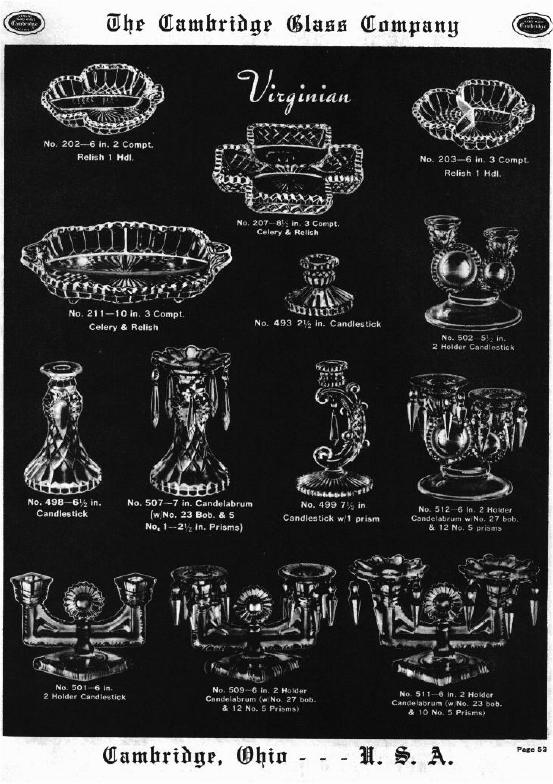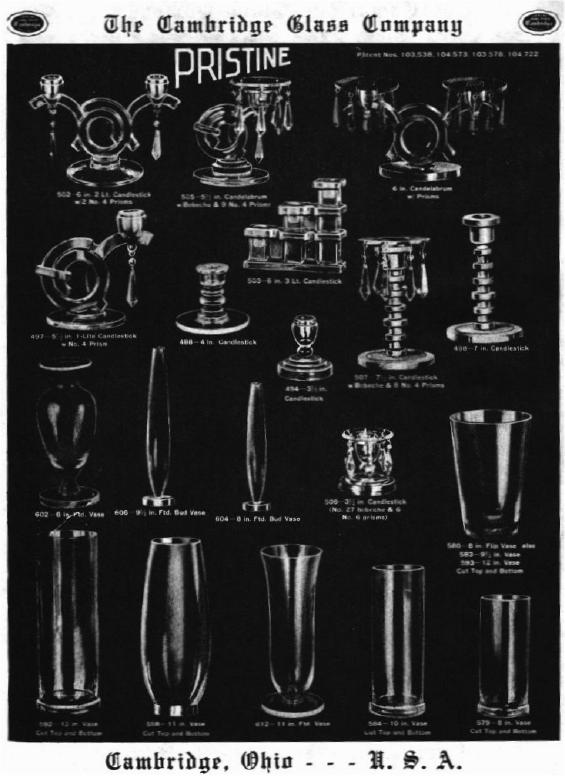Candlesticks Part IV
by Mark A. Nye
Issue No. 219 - July 1991
Some of the more unusual Cambridge candlesticks come from two lines, Pristine and Virginian. Both of these lines were introduced in the 1930s, Pristine in 1937 and Virginian in 1938. While the Pristine line survived until the late 1950s, and the company's demise, the Virginian line was dropped at some point in the 1940s, probably during the war years. The history of the Pristine line was covered in two articles, published in the November 1986 and January 1987 issues of the Cambridge Crystal Ball, and will not be repeated here.
The Virginian line was described in the February 1938 issue of China, Glass and Lamps as follows:
"The 'Virginian' is the new pressed line shown by the Cambridge Glass Co. - a diamond pattern developed in a line of table items, decorative pieces and stemware with the design blown in the bowl. It is a reproduction of an early American design, and is done in crystal only."
"The salad bowl ... is from the Cambridge Glass Co. -- one of their newest pressed lines, called 'Virginian.' Early American in theme, this new design has a diamond pattern and a deeply-ridged edge line, and it is shown in a full line of flatware and fancy items, together with stemware."
The pattern is much more evident in such pieces as relishes, seen above the candlesticks on the catalog page reprinted here (next page), than it is on the candlesticks.
There are a total of five Virginian candlesticks and three of these were used to make up candelabra. The candlesticks are designated #V493, #V498, #V499, #V501 and #V502; while the candelabra are #V507, #V509, #V511 and #V512 (here the V stands for Virginian). As stated in the trade journal quotes, Virginian was made in crystal only and hence Virginian candlesticks will be found only in crystal. Note carefully the three different prisms used on the Virginian candlesticks and candelabra. The #V499 candlestick uses a single #4 prism while the #V507 uses the more familiar #1 prism and the #V509, #V511 and #V512 use the #5 prism. The reader should also pay close attention to the different types of bobeches used; the #23 with #V527 and #V511, while the #V509 and #V512 utilized the #27 bobeche. None of the Virginian candlesticks or candelabra are frequently seen and it will be a very lucky collector who is able to collect them all.
Note the basic shape of the Virginian candlestick #499. This same shape was also used in the Caprice line (#C70) and in the Martha line where the #497 candelabrum has the same basic shape.
Information has been found that indicates the Virginian #501 candlestick may have been etched Rosepoint. However, this author has yet to see or hear of the existence of an actual example. The possibility also exists that pieces of the Virginian line may have been frosted, much in the same manner of the Caprice Alpine decoration. However, other than in the case of a few pieces of stemware, this too remains to be proven. Other than these two possibilities, Virginian candlesticks and candelabra were not decorated.
Apparently the Virginian line was discontinued sometime during the 1940s, as it does not appear in the 1949 Cambridge catalog or any of its supplements. The relative infrequency with which it is seen indicates this was not a major pattern for Cambridge and that only a small to moderate amount was made and sold.
A few of the Virginian molds were, during 1956-57, brought out of storage and altered to create the Jenny Lind line. However, none of the candlestick molds were so used.
All of the Pristine candlesticks and candelabra shown on the catalog page (at end of this article) were in the line prior to January 1940. They were either a part of the line from the beginning or added during the years 1937-39. Of the six basic candleholders shown on this page, only one, the #P494, remained in the line as the 1940s ended.
 Four other Pristine candlesticks are shown with this article; these
being the #P500 6½" 1-lite candlestick (sometimes referred to as the
Leaf candlestick) and the three Round candlesticks #P489, #P490 and
#P491, companions to the previously discussed square candlesticks.
Four other Pristine candlesticks are shown with this article; these
being the #P500 6½" 1-lite candlestick (sometimes referred to as the
Leaf candlestick) and the three Round candlesticks #P489, #P490 and
#P491, companions to the previously discussed square candlesticks.
 Of these, only the #P500 was illustrated in the 1949 Cambridge
catalog and it was the last of this group of Pristine candleholders to
be introduced, dating to circa 1941. The Round Pristine candlesticks
were probably a part of the line from its earliest days.
Of these, only the #P500 was illustrated in the 1949 Cambridge
catalog and it was the last of this group of Pristine candleholders to
be introduced, dating to circa 1941. The Round Pristine candlesticks
were probably a part of the line from its earliest days.
Since Pristine was essentially a crystal line, these Pristine candlesticks and candelabra will only be found in crystal. The #P500 candlestick will be found etched Rosepoint and perhaps with other etchings as well. The #P498, #P502, #P507, and the 6" candelabrum with prisms (aka #P520) were available from the 1940 price list with the gold decoration D/1054 while #P494, #P506, #P502 and the #P520 were offered with the gold decoration D/1050. Both of these decorations were based on an etched laurel band: D/1054 has a gold band on either side of the etching while D/1050 consists of the etching being gold encrusted.
The following is taken from the text of a Cambridge advertisement for Pristine with D/1050 that appeared in the October 1930 issue of China, Glass and Lamps.
"Because it achieves special distinction without extravagance, Cambridge Gold Encrusted Crystal is an ideal gift choice. The Cambridge process (developed in America) actually fuses pure gold deep into the crystal at great heat, creating a decoration of satin richness, as permanent as it is beautiful and surprisingly moderate in cost."
The #P520 6" candelabrum with two #25 bobeches and 18 #4 prisms listed in 1940 for $157.50 per dozen or $26.25 per pair. The #P494 candlestick listed for #33.75 per dozen or $5.62 per pair. I will let the reader judge if these are "surprisingly moderate" prices.
In addition to the Virginian and Pristine candlesticks, study the illustrations of the Pristine vases and the other pieces of Virginian shown. With the exception of the flip vase, the Pristine vases have the characteristic base which should serve to identify them if they are given more than a cursory glance. The Virginian pieces are seldom seen and could be overlooked if the shopper was not being diligent.
To be continued ...


